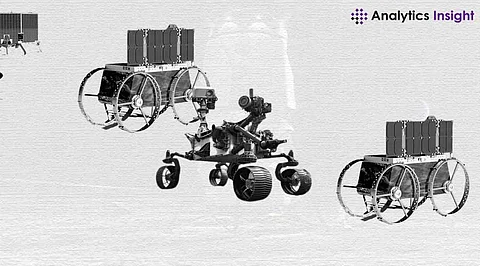

NASA continues to put in efforts to establish its presence on the moon as part of the Artemis campaign. One of the primary tasks in this process is the moving of cargo from one place to another on the lunar surface.
To maintain the safety of the cargo, NASA plans to send a team of robots as crew members. These cargos, or payloads, consist of different things including certain scientific experiments and large technology to set up the infrastructure.
In September, the team at NASA’s Langley Research Center in Virginia ran demonstrations of their robotic system called LANDO (Lightweight Surface Manipulation System AutoNomy Capabilities Development for Surface Operations and Construction).
The team spent the last couple of years infusing robotic hardware along with a software system that helps the robot work automatically.
The demonstration of LANDO took place in a simulated lunar environment with fake boulders and a model lunar lander. The team placed a small metal box on a pedestal, a robotic arm with sensors. They also scanned the area to locate the box using encoded markers similar to QR codes. Amelia Scott, a team member, used a graphic interface to choose a location for LANDO to place the payload.
The arm moved slowly and methodically, lifting the payload from the pedestal and placing it on the lunar surface. The process was repeated with a small model rover. The team demonstrated the system’s repeatability and the ability to control it. They also showed how it can plan paths around obstacles.
The successful demo marks the end of this project phase. But is the first step in developing a larger system for the Moon. The next step is to test an engineering design unit on a lunar lander as part of NASA’s Commercial Lunar Payload Services (CLPS) initiative. The team is seeking industry partners to commercialize the capability.
The LANDO system, funded by NASA’s Space Technology Mission Directorate (STMD), could be scaled up for larger tasks on the Moon. Such as offloading habitats and surface power systems.
This technology is part of NASA’s efforts to advance space technologies for future missions, including the Artemis campaign and robotic crewed missions to Mars. The LANDO system’s development is part of NASA’s broader strategy to enhance robotic capabilities for lunar missions.
The success of LANDO could pave the way for more advanced robotic systems that can handle various tasks. These tasks include constructing habitats, deploying scientific instruments, and setting up power systems on the lunar surface.
Additionally, collaboration with commercial partners through the CLPS initiative is crucial. It allows NASA to leverage private sector innovation and efficiency, accelerating the development and deployment of new technologies.
This partnership model is expected to play a significant role in future lunar and Mars missions, ensuring that the necessary infrastructure and support systems are in place for long-term human exploration.
The robotic crew offers several benefits. Robots can work continuously without breaks, increasing productivity. They can handle hazardous tasks, reducing risks to human astronauts. Advanced sensors and software allow robots to perform tasks with high accuracy. Additionally, the technology can be scaled up for larger missions and more complex tasks, making it highly versatile.
The LANDO system represents a significant step forward in robotic capabilities for lunar missions. Its success could lead to more advanced systems that support NASA’s long-term goals for lunar and Mars exploration, ensuring the necessary infrastructure and support systems are in place for sustainable human presence.
